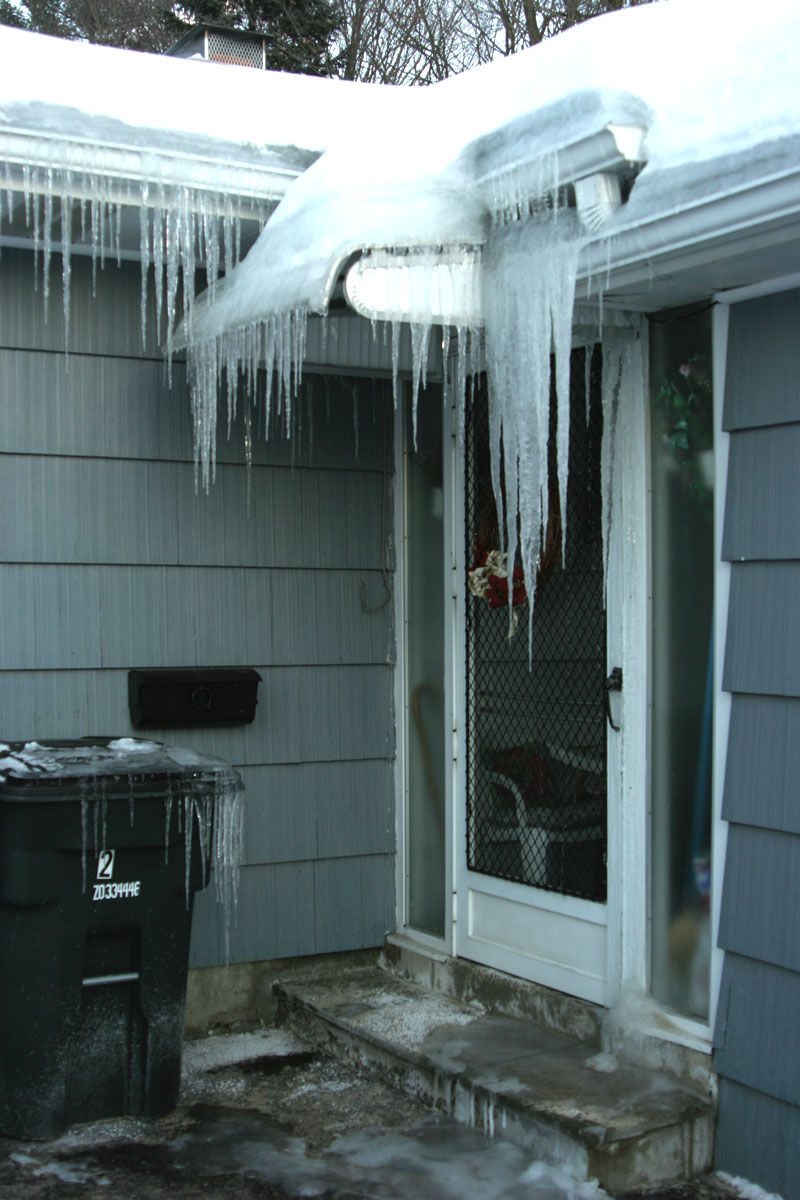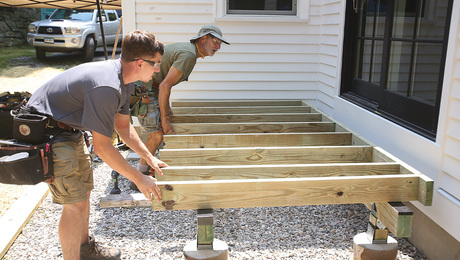Summer is the Time to Head Off Ice Dams

Winter seems like a bad dream, doesn’t it? But guess what? It will be back, and with it will come cold temperatures, snow, and, unfortunately, ice dams. Few problems plague homeowners in snow country more relentlessly than the telltale accumulation of icicles along roof eaves, and the water damage that all too often accompanies it.
Summertime repairs to roofs damaged over the winter won’t do much good unless the underlying causes of ice dams are identified and corrected.
There’s not much mystery in why ice dams form (Paul Fisette’s article in FHB provides a good summary of the problem). Snow and ice melting on a warm roof deck run down to the edge of the roof where it refreezes. Icicles form, and over time a thick layer of ice collects at the eave. As more water melts, it accumulates behind this dam, enough so that water can work its way underneath the roof cladding and into the house.
RELATED ARTICLES
A Crash Course in Roof Venting
New Attic Insulation Pays Its Own Way
GBA Encyclopedia: Vented or Unvented Attic?
Blogs: Roofing and Siding Jobs Are Energy-Retrofit Opportunities
Water can stain ceilings, soak into insulation and render it useless, make oatmeal out of drywall and allow rot in both sheathing and structural framing. In short, it makes a mess.
While builders, designers and building scientists seem to agree on the general causes of ice dams , there’s still some debate on the exact construction details that will prevent them. Known fixes include installing an adequate amount of insulation for the climate, and creating an effective air barrier that prevents warm air from the house from filtering into the roof system.
Where builders sometimes part company is over the importance of roof ventilation. Some insist that continuous ventilation beneath the roof deck from eave to ridge, what’s called a “cold roof,” is an essential part of keeping roofs ice free. Others have no qualms about a “hot roof,” one that is sealed to outside air, providing it’s assembled correctly.
It’s not the roof itself: Air seal
One thing that doesn’t have much to do with the problem is the roof cladding itself. GreenBuildingAdvisor senior editor Martin Holladay disposes of this red herring in an essay in which he recalled an interview he’d conducted some years earlier with the late Tony Woods, a Canadian building scientist.
Woods told Holladay about a woman who had called three different roofers in as many years in an effort to stop a persistent ice damming problem. The first talked her into replacing the roof, and the following winter the ice dams were back. She called in the second roofer, who said the first one hadn’t ventilated the roof properly. So he built a second roof over the first one. The problem was still there. Finally, she called in a third roofer who, with Woods, took a closer look at what they were dealing with.
There were pot lights galore,” Woods told Holladay. “…When we said that the problem is not the roof, the lady burst into tears.”
No, the problem wasn’t the roof. It was air leakage around the recessed lights that allowed warm air from the house to keep the bottom of the roof deck correspondingly warm, and melt the snow that collected there over the winter. Hence, ice dams.
That led Holladay to the first rule for preventing ice dams: seal all air leaks. Recessed lighting is but one possible cause. Wiring and plumbing chases and gaps around the chimney or air ducts where they enter the attic also are likely culprits. Any gaps, cracks or other defects in the air barrier should be sealed with polyurethane foam, caulk or another reliable sealant. All ventilation fans must be ducted to the outside of the building, preferably through a gable end and not into the soffits.
A white paper published by the Canada Mortgage and Housing Corporation provides an excellent description of where air leaks can be found, and makes suggestions on how to seal them. Start with a careful inspection of the attic But as the CMHC and other sources, note, the most reliable way of tracking down air leaks between the house and attic may be a blower door, a device that raises or lowers air pressure inside the house and makes air leaks easier to find.
Although the causes of ice damming don’t hinge on the choice of roofing, snow can’t turn into an ice dam if it’s not on the roof. Metal roofing may help prevent the problem by shedding snow before it has a chance to accumulate.
Add enough insulation
As important as air sealing is insulation. In the northern tier of the United States–climate zones 6, 7 and 8–the International Residential Code requires ceilings be insulated to R-49. As Holladay points out, that is the equivalent of 20 in. of blown-in fiberglass or 14 in. of fiberglass batts, cellulose or low-density, open-cell polyurethane foam. IRC-recommended R-values should be viewed as minimums; high performance houses in cold climates often have roofs that are insulated to R-60 or more.
Adding enough insulation at the perimeter of the roof is key, and that gets complicated when there isn’t enough room between the top plate of the wall and the bottom of the roof sheathing. High-density, closed-cell polyurethane foam, with an R-value of 6 or more per inch, is an effective choice here, but it may have to be supplemented with rigid foam insulation on top of the roof deck, an option only in new construction or when the roof is being replaced anyway. In new construction, using raised-heel trusses allows more room for insulation over the top plate of the wall.
If only it were a case of looking up the nominal R-value of a particular type of insulation and going from there. It’s not. Insulation is a topic that gets complicated very quickly. For example, fiberglass batts, have an R-value roughly equivalent to cellulose, and theoretically can provide adquate thermal insulation. But a number of studies have found that fiberglass insulation is often badly installed, and it ranks below both cellulose and sprayed-in polyurethane foam in its ability to control air leaks. Why is it used so often? It’s cheap.
Closed-cell foam, offers much higher R-values per inch and can serve as both an air and vapor barrier. However, it’s much more expensive than other types of insulation, and some homeowners have reported adverse reactions to the potent petrochemicals mixed on site to make it. Open-cell foam comes in water-blown varieties with fewer noxious chemicals, but the R-values are lower and low-density foam is an air but not a vapor barrier. So, understanding the difference between these types of insulation becomes important.
A related issue is thermal bridging, which in this case means the loss of heat through framing members in the roof. Even if 2×10 rafter bays were completely filled with high-density foam (for an R-value of roughly 60), the rafters themselves are only providing the equivalent of about R-9. Every 16 in., a rib of R-9 material interrupts an otherwise well-insulated roof. (This is exactly the situation in my own roof, which gathers quite a bit of ice in the winter.) Insulation contractors sometimes suggest using less foam than is actually needed on the grounds that the foam is such an effective air barrer, as this article discusses. Moral of the story: R-value is still R-value.
Thermal bridging can be prevented with a layer of rigid foam insulation, either above the roof deck or attached to the bottoms of the rafters. In super-cold climates, a roof might be insulated with as much as 10 in. of rigid foam, as this report from Building Science Corp. describes.
Ventilating the roof
Ventilating the roof–that is, providing eave to ridge channels for air passage in each rafter bay–can be a somewhat more contentious subject. Although unventilated, hot roofs are becoming increasingly common, some builders believe firmly that ventilation is an important weapon against ice dams.
“To vent or not to vent, that is the question,” wrote Skylar Swinford in a comment attached to Holladay’s blog. “I have seen perfectly sealed and insulated unvented roof systems perform flawlessly. I have also seen perform poorly. The same goes for vented roof systems. The deciding factor is the complexity of the roof geometry and the type of framing materials used.”
“The conventional wisdom is that adding cavity ventilation channels between the roof rafters will cool down the roof enough to offset structural conduction and heat loss, in practice this doesn’t work so well,” Swinford continues. “Typically, adding cavity ventilation to a complex roof loaded with valleys and dimensional framing will not completely prevent ice damming. Much of the time the complex roof design leads to deadhead cavities that don’t interconnected to the ridge vent and soffit vent. Furthermore, it is not uncommon for the average ridege vent to be covered in a couple feet of snow in the dead of winter. This tends to put a damper on ventilation rates.”
On his own priority list, Holladay ranks ventilation third, behind air-sealing and insulation. “Although it is an admission of failure, this type of roof ventilation often makes sense,” he writes. “It’s a kind of insurance.”
Holladay adds this: “Although so-called hot roofs (roofs without any ventilation) can work well, it’s important to note that ice dams can still form on a hot roof if the snow is deep enough. (Very deep snow acts like insulation. If your roof is covered with two feet of fluffy snow, the bottom of the snowpack is insulated from cold outdoor temperatures. That raises the chance that melting will occur.)
“So, if your climate is very snowy, you probably want to stick with a cold (ventilated) roof.”
Others are more adamant about ventilation. Among them is Robert Riversong, who wrote, “Adequate, balanced and complete roof ventilation not only limits or prevents ice dam formation but also reduces summer radiant heat gain, extends the life of composite roofing materials, removes vagrant moisture, and dramatically increases the durability of the roof deck by creating a drying potential that simply doesn’t exist in a hot roof.”
Riversong ranks ventilation as a primary defense against ice dams, not a second-tier strategy.
William Rose, a well known research architect, also has weighed in on this issue.
Whether the roof is vented or unvented, careful detailing matched to the demands of the local climate, is important in preventing a loss of heat and consequent ice dams. A variety of approaches are available at the Green Building Advisor Strategies & Details section.
Other factors: Waterproof membranes
A first line of defense against water damage caused by ice damming is a peel-and-stick membrane, such as Grace Ice & Water Shield. It does nothing to stop ice dams from forming, but it is designed to stop water from getting in. If used–and there’s no reason not to–it should be applied from the eave to a point 3 ft. above the plane of the exterior wall. Roof valleys are another place where this material can help head off moisture problems.
Yet it’s increasingly common to see an entire roof covered with the material. In coastal or high-wind areas , the rationale may be that this provides much more protection than conventional felt with membrane applied only in valleys and along eaves. But there can be risks here, too. The stuff is not foolproof, and when water gets in, it has a hard time getting out. This is especially dangerous when non-permeable insulation is applied against the bottom of the roof sheathing, like closed-cell polyurethane foam.
Holladay calls this the “dreaded foam sandwich.”
Fine Homebuilding Recommended Products
Fine Homebuilding receives a commission for items purchased through links on this site, including Amazon Associates and other affiliate advertising programs.

8067 All-Weather Flashing Tape

Reliable Crimp Connectors

Handy Heat Gun
























View Comments
Scott, I think you make some great comments here and you've mentioned some very accomplished people. All of the possible cures to ice damms you mention have worked (and I have witnessed many of them) in certain applications. However, I tend to disagree with the idea that the choice of roof doesn't matter. Has anyone done a test to see what the temperature increases are on a black colored roof of a home where everything else was done perfectly? Meaning, the attic was ventilated properly, the insulation was more than adequate, the ceiling was sealed up...etc.
If you have ever touched a black object (a car for example) on a sunny day, you know how hot it can get. How about touching a black sign that the sun has been shining on directly? The sign is naturally vented on all sides, yet it still gets hot. I believe this same thing happens on roofs that have a dark color. The wind clears off sections of the roof...the sun hits those dark sections and heats up the surface...causing melting in those locations but not in the snow covered locations.
The engineer in me wants to believe we can eliminate the heat gain on the roof with the concepts you mentioned in the article. However, my sixteen years of home building experience tells me I'm better off putting rubber underlayment under the complete roof if I want to have a chance at eliminating the leaks.
Thanks more making us think!
Michael
ArmchairBuilder.com
Can anyone say all of my projects worked out the way I intended them to , always? of course not. It appears that we have these forums to throw out ideas to take our best stab at a particular issue. It's great to have the wealth of knowledge to draw from which this forum brings. Ultimately, we must make our decisions on protecting from ice dams on an individual details of a particular job basis. Again, great ideas to draw from!
Jaime
HPH Construction, Mason, MI